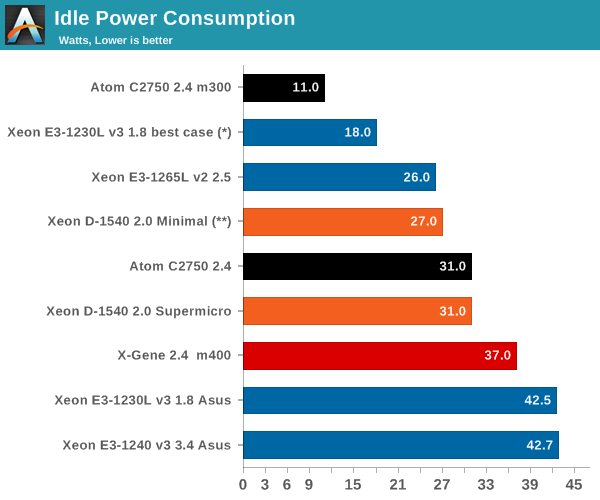The Intel Xeon D Review: Performance Per Watt Server SoC Champion?
by Johan De Gelas on June 23, 2015 8:35 AM EST- Posted in
- CPUs
- Intel
- Xeon-D
- Broadwell-DE
Saving Power
Efficiency is very important in many scenarios, so let's start by checking out idle power consumption. Most of our servers have a different form factor. Some (X-Gene, Atom c2750 in HP Moonshot) are micro-servers sharing a common PSU and some are based upon a motherboard that has a lot of storage interfaces (the C2750 server, the SYS-5028D-TN4T). Our Xeon E5 was running inside a heavy 2U rackserver, so we did not include those power readings.
But with some smart measurements, some deductions and a large grain of salt we can get somewhere. We ask our readers to take some time to analyze the measurements below.

(*) Calculated as if the Xeon E3 was run in an "m300-ish" board.
(**) See our comments
The server based upon the ASUS P9D-MH is the most feature rich board in our comparison. The C2750 measurements show how much difference a certain board can make - the Asrock C2750D4I which targets the storage market needs 31 W, and by comparison the m300 micro server inside the HP Moonshot needs only 11 W. The last measurement does not include the losses of the PSUs, but it still shows how much difference, even in idle, the board makes.
The board inside the supermicro SYS-5028D-TN4T - the Supermicro X10SDV-TLN4F - is a bit more compact than the Asus P9D-MH, and is very similar to the ASRock C2750D4I. But inside SYS-5028D-TN4T we also find a storage backplane and a large fan in the back. So we disabled several components to find out what their impact wass.
- 0.5 Watt for the large fan in the back of chassis
- 0.5 Watt for the fan on top of the heatsink
- 0.5 Watt for the storage backplane
- 3.5 Watt for 10 Gbit Ethernet PHY
In order to make the Supermicro similar to the C2750DI, we disable the large fan, we removed the storage backplane and disable the 10 Gb Ethernet PHY in BIOS. The result was that the idle power lowered from 31W to 27W. The only difference was that the Asrock C2750D4I uses a large passive heatsink and the Supermicro X10SDV-TLN4F uses a small fan. We found out that the fan uses about 0.5 Watt, so we have reason to believe that the Xeon D consumes slightly less or similar at idle than the Atom C2750.
For those who have missed our review of the X-Gene 1, remember that the software ecosystem for ARM is not ready yet (ACPI and PCIe support) and that the Ubuntu running on top of the X-Gene was not the vanilla Ubuntu 14.04 but a customized/patched one. Also the X-Gene 1 is baked with an older 40 nm process.










90 Comments
View All Comments
julianb - Saturday, October 31, 2015 - link
Thanks for the reply, man.And sorry for my late reply, totally forgot about this thread :)
eva2000 - Tuesday, June 23, 2015 - link
Nice... Xeon D-1540 is awesome, but I wish it was clocked 0.2Ghz higher across the board would be just enough to tip that scale versus E5. Did my own benchmarks at https://community.centminmod.com/threads/2864/ :)extide - Wednesday, June 24, 2015 - link
Thats probably exactly why it ISNT clocked 0.2Ghz higher across the board ;)I'm sure Intel wants to see some space between this and E5.
boogerlad - Tuesday, June 23, 2015 - link
If this was marketed for the consumer market with the ability to overclock, this would outsell everything completely. This is what the enthusiast needs!!!Refuge - Tuesday, June 23, 2015 - link
I don't think this is going to do much of anything for an enthusiast.Unless they are interested in building a server for some experiment or project.
JohanAnandtech - Wednesday, June 24, 2015 - link
I still think the i7 59xx series is a better match for consumers: higher clocks and thus ST performance. The Xeon D most interesting features such as integrated 10 GBe and low power don't interest most performance consumers. Most people will have a hard time saturating a 1 GBe line and power savings are not a priority.tspacie - Wednesday, June 24, 2015 - link
Seems to tick all the boxes for a software development machine. Very good at compilation. Reasonably priced for the performance. Low power. ECC memory. I'm temptedextide - Wednesday, June 24, 2015 - link
EXACTLY what I was thinking!MrSpadge - Saturday, June 27, 2015 - link
I would be very tempted by such a chip as well, using it for BOINC. However, Broadwell looses some of the power efficiency advantage if you push it harder, i.e. the largest gains are at low and moderate frequency. Perfect for such server chips and mobile ones, but not so much for people aiming for 4+ GHz.MaxKreimerman - Tuesday, June 23, 2015 - link
Sounds impresive in just 45w package, but imposible to find in the retail sites such as newegg or wiredzone